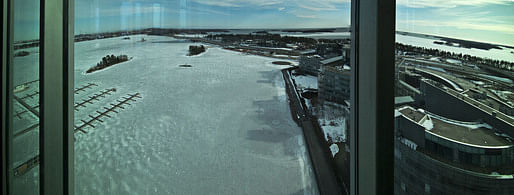
Much has happened, and it seemed, for a fleeting moment, spring was here to stay in Helsinki; we found ourselves with consecutive days of sunshine, blue skies, melting snow, thawing sea ice, and the clocks jumping forward one hour.
 Then on April 1, like a sick joke, we got 4 more inches of snow. No Finns seemed too
Then on April 1, like a sick joke, we got 4 more inches of snow. No Finns seemed too
shocked about it. We even got more snow today, though it seems the sun is finally
winning the battle. Our understanding is that this back and forth can very well go on
into early May. At least we don’t have to wear hats.
Things are very very busy. Here is the next installment.
The Tall Office Building Efficiently Considered
As an ongoing component of building and firm visits for our Building Technologies class, yesterday we went to the Kone Headquarters outside of Helsinki for a fascinating meeting with Johannes De Jong, Head of Technology at Kone.

Kone is one of the world leaders in escalators and elevators. They operate around
the world and work with virtually every major architecture firm including an
exclusive license with Foster + Partners.
Over a few hours, we learned a great deal about the nuances, technology, and design of vertical circulation: knowing how many elevators to use, placement,
sizing, types of lifts, and additional strategies. The name of the game is
efficiency, efficiency, and efficiency. Be it a matter of safety, comfort, or economy,
the creation of efficient people flow is paramount in a high rise building.
Elevator systems in Supertalls are less elevators than they are high-tech vertical
transit systems. There is more technology in eight modern high speed elevators than
there is in a jumbo jet, and it begins with an understanding of a building’s ecology;
the utilization of each floor allows for anticipation of human flow and density
behavior (i.e. a floor with a night club is likely to have peak use at different times than a floor with an office, resulting in greater demand for the elevator that floor) The use of shuttle elevators, local elevators, and freight elevators all come into play, with a sophisticated system of synching,
anticipating, lessening people’s waiting time, and increasing safety. The Mecca
Royal Clock Tower, for example, is sophisticated enough that it can evacuate all 80,000 inhabitants in 20 minutes. To put this into perspective, The World Trade Center could evacuate all users in about 3 hours. This was state of the art of the time.

What does this all mean? Just like the original Otis elevator brought the American
city above 5 stories, it seems these new technologies are going to keep pushing
people to build taller and taller. With the continuing trend of global urbanization,
1,000,000 people move to or are born in cities each week. This is a lot of new dense
housing and use that must be accounted for. If people do not feel inconvenienced by
tall buildings, there seems to be no reason it will stop. Johannes was confident that
this was just the start of reaching the potential of elevator technology.
We also toured the headquarters, of the Kone Building, an 18 story tower designed
by the Finnish Firm SARC. In addition to the state-of-the-art
glass elevators (of course) there was a great, diaphonous sky terrace (complete with Sauna) affording compelling views over the landscape, and a nicely detailed double curtain wall system with screen prints of traditional elevator counterweights.
 It was especially interesting to see this company, from the Social Democratic,
It was especially interesting to see this company, from the Social Democratic,
relatively low-rise country of Finland, making such a contribution to the justification
and enabling of supertall towers and symbols of corporate wealth.

On a playful and nostalgic note, the insight into the nuances of elevator design reminded us of the classic 1994 game, SimTower: The Vertical Empire. The goal of the game is to design a five star building that consists of restaurants, apartments, offices, and hotels, but the core of the game circulated around properly setting up a well lubricated and functioning system of stairs, escalators and elevators. A game, where even a primitive understanding of elevator design becomes the beating heart of a larger system.
A very engaging and absorbing afternoon.

This work by A.D.Morley & J.A.Wong is licensed under a Creative Commons Attribution-NonCommercial-NoDerivs 3.0 Unported License.
A new adventure begins as we finish one chapter; we hope to share our story with you. We are graduates of Washington University in St. Louis, Sam Fox School of Design & Visual Arts.
1 Comment
maybe you guys can help out with the prison design at Penn
Block this user
Are you sure you want to block this user and hide all related comments throughout the site?
Archinect
This is your first comment on Archinect. Your comment will be visible once approved.